Mutagenesis in Rice: The Basis for Breeding a New Super Plant
- PMID: 31781133
- PMCID: PMC6857675
- DOI: 10.3389/fpls.2019.01326
Mutagenesis in Rice: The Basis for Breeding a New Super Plant
Abstract
The high selection pressure applied in rice breeding since its domestication thousands of years ago has caused a narrowing in its genetic variability. Obtaining new rice cultivars therefore becomes a major challenge for breeders and developing strategies to increase the genetic variability has demanded the attention of several research groups. Understanding mutations and their applications have paved the way for advances in the elucidation of a genetic, physiological, and biochemical basis of rice traits. Creating variability through mutations has therefore grown to be among the most important tools to improve rice. The small genome size of rice has enabled a faster release of higher quality sequence drafts as compared to other crops. The move from structural to functional genomics is possible due to an array of mutant databases, highlighting mutagenesis as an important player in this progress. Furthermore, due to the synteny among the Poaceae, other grasses can also benefit from these findings. Successful gene modifications have been obtained by random and targeted mutations. Furthermore, following mutation induction pathways, techniques have been applied to identify mutations and the molecular control of DNA damage repair mechanisms in the rice genome. This review highlights findings in generating rice genome resources showing strategies applied for variability increasing, detection and genetic mechanisms of DNA damage repair.
Keywords: DNA repair; Oryza sativa L; functional genomics; genetic variability; mutagenesis; mutation detection; random mutations; targeted mutations.
Copyright © 2019 Viana, Pegoraro, Busanello and Costa de Oliveira.
Figures
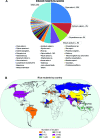
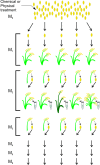


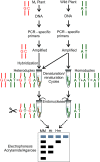
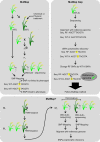

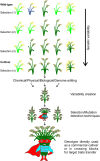
References
-
- Akter M. B., Piao R., Kim B., Lee Y., Koh E., Koh H.-J. (2014). Fine mapping and candidate gene analysis of a new mutant gene for panicle apical abortion in rice. Euphytica 197, 387–398. 10.1007/s10681-014-1074-8 - DOI
-
- Almadanim M. C., Alexandre B. M., Rosa M. T. G., Sapeta H., Leitão A. E., Ramalho J. C., et al. (2017). Rice calcium-dependent protein kinase OsCPK17 targets plasma membrane intrinsic protein and sucrose-phosphate synthase and is required for a proper cold stress response. Plant. Cell Environ. 40, 1197–1213. 10.1111/pce.12916 - DOI - PubMed
Publication types
LinkOut - more resources
Full Text Sources

